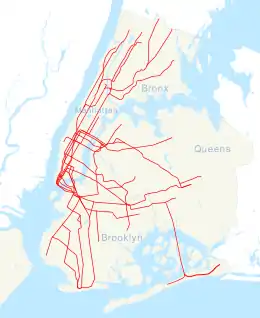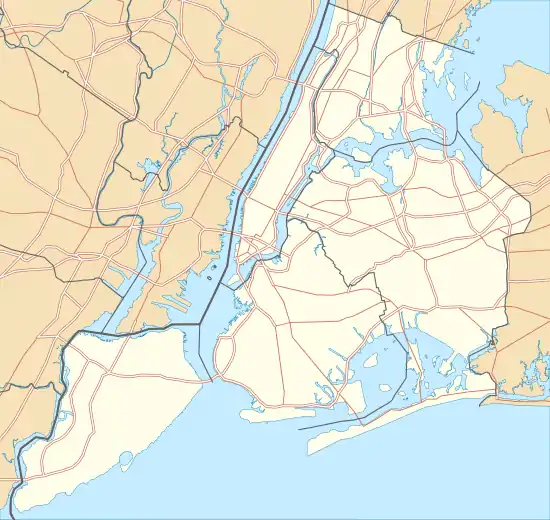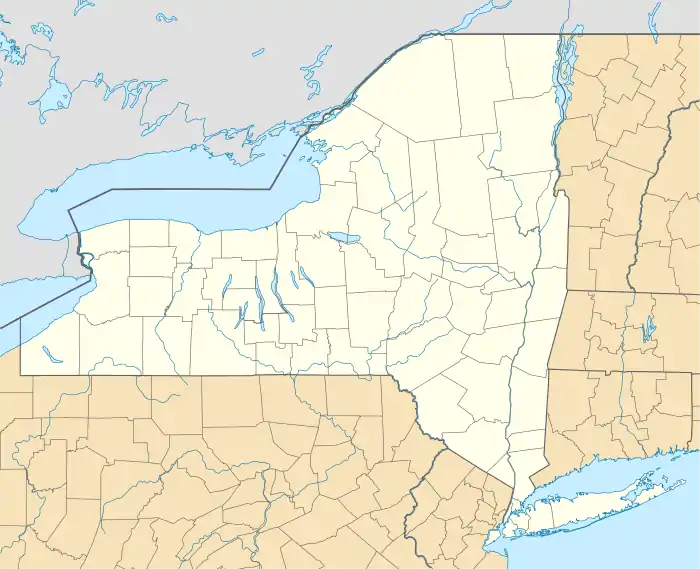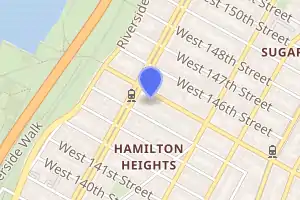145th Street station (IRT Broadway–Seventh Avenue Line)
145th Street is a local station on the IRT Broadway–Seventh Avenue Line of the New York City Subway. Located at the intersection of Broadway and 145th Street in Hamilton Heights, Manhattan, it is served by the 1 train at all times.
145 Street | ||||||||||||||||||||||||||||||||||||||||||||||||||||||||||||||||||||||||||||||||||||||||||||||||
|---|---|---|---|---|---|---|---|---|---|---|---|---|---|---|---|---|---|---|---|---|---|---|---|---|---|---|---|---|---|---|---|---|---|---|---|---|---|---|---|---|---|---|---|---|---|---|---|---|---|---|---|---|---|---|---|---|---|---|---|---|---|---|---|---|---|---|---|---|---|---|---|---|---|---|---|---|---|---|---|---|---|---|---|---|---|---|---|---|---|---|---|---|---|---|---|---|
 Uptown platform | ||||||||||||||||||||||||||||||||||||||||||||||||||||||||||||||||||||||||||||||||||||||||||||||||
| Station statistics | ||||||||||||||||||||||||||||||||||||||||||||||||||||||||||||||||||||||||||||||||||||||||||||||||
| Address | West 145th Street & Broadway New York, NY 10031 | |||||||||||||||||||||||||||||||||||||||||||||||||||||||||||||||||||||||||||||||||||||||||||||||
| Borough | Manhattan | |||||||||||||||||||||||||||||||||||||||||||||||||||||||||||||||||||||||||||||||||||||||||||||||
| Locale | Hamilton Heights | |||||||||||||||||||||||||||||||||||||||||||||||||||||||||||||||||||||||||||||||||||||||||||||||
| Coordinates | 40.826°N 73.95°W | |||||||||||||||||||||||||||||||||||||||||||||||||||||||||||||||||||||||||||||||||||||||||||||||
| Division | A (IRT) | |||||||||||||||||||||||||||||||||||||||||||||||||||||||||||||||||||||||||||||||||||||||||||||||
| Line | IRT Broadway–Seventh Avenue Line | |||||||||||||||||||||||||||||||||||||||||||||||||||||||||||||||||||||||||||||||||||||||||||||||
| Services | 1 | |||||||||||||||||||||||||||||||||||||||||||||||||||||||||||||||||||||||||||||||||||||||||||||||
| Transit | ||||||||||||||||||||||||||||||||||||||||||||||||||||||||||||||||||||||||||||||||||||||||||||||||
| Structure | Underground | |||||||||||||||||||||||||||||||||||||||||||||||||||||||||||||||||||||||||||||||||||||||||||||||
| Platforms | 2 side platforms | |||||||||||||||||||||||||||||||||||||||||||||||||||||||||||||||||||||||||||||||||||||||||||||||
| Tracks | 3 (2 in regular service) | |||||||||||||||||||||||||||||||||||||||||||||||||||||||||||||||||||||||||||||||||||||||||||||||
| Other information | ||||||||||||||||||||||||||||||||||||||||||||||||||||||||||||||||||||||||||||||||||||||||||||||||
| Opened | October 27, 1904[1] | |||||||||||||||||||||||||||||||||||||||||||||||||||||||||||||||||||||||||||||||||||||||||||||||
| Station code | 304[2] | |||||||||||||||||||||||||||||||||||||||||||||||||||||||||||||||||||||||||||||||||||||||||||||||
| Opposite- direction transfer | No | |||||||||||||||||||||||||||||||||||||||||||||||||||||||||||||||||||||||||||||||||||||||||||||||
| Traffic | ||||||||||||||||||||||||||||||||||||||||||||||||||||||||||||||||||||||||||||||||||||||||||||||||
| 2019 | 2,936,613[3] | |||||||||||||||||||||||||||||||||||||||||||||||||||||||||||||||||||||||||||||||||||||||||||||||
| Rank | 169 out of 424[3] | |||||||||||||||||||||||||||||||||||||||||||||||||||||||||||||||||||||||||||||||||||||||||||||||
| Station succession | ||||||||||||||||||||||||||||||||||||||||||||||||||||||||||||||||||||||||||||||||||||||||||||||||
| Next north | 157th Street: 1 | |||||||||||||||||||||||||||||||||||||||||||||||||||||||||||||||||||||||||||||||||||||||||||||||
| Next south | 137th Street–City College: 1 | |||||||||||||||||||||||||||||||||||||||||||||||||||||||||||||||||||||||||||||||||||||||||||||||
| ||||||||||||||||||||||||||||||||||||||||||||||||||||||||||||||||||||||||||||||||||||||||||||||||
| ||||||||||||||||||||||||||||||||||||||||||||||||||||||||||||||||||||||||||||||||||||||||||||||||
| ||||||||||||||||||||||||||||||||||||||||||||||||||||||||||||||||||||||||||||||||||||||||||||||||
| ||||||||||||||||||||||||||||||||||||||||||||||||||||||||||||||||||||||||||||||||||||||||||||||||
Built for the Interborough Rapid Transit Company (IRT), the 145th Street station was constructed as part of the city's first subway line, which was approved in 1900. Construction on the segment of the line that includes 145th Street started on May 14 of the same year. The station opened on October 27, 1904, as one of the original 28 stations of the New York City Subway. The station's platforms were lengthened in 1948.
The 145th Street station contains two side platforms and three tracks; the center track is not used in regular service. The station was built with tile and mosaic decorations. The platforms contain exits to 145th Street and Broadway and are not connected to each other within fare control.
History
Construction and opening
Planning for the city's first subway line dates to the Rapid Transit Act, authorized by the New York State Legislature in 1894.[4]:139–140 The subway plans were drawn up by a team of engineers led by William Barclay Parsons, chief engineer of the Rapid Transit Commission. It called for a subway line from New York City Hall in lower Manhattan to the Upper West Side, where two branches would lead north into the Bronx.[5]:3 A plan was formally adopted in 1897, and legal challenges were resolved near the end of 1899.[4]:148 The Rapid Transit Construction Company, organized by John B. McDonald and funded by August Belmont Jr., signed Contract 1 with the Rapid Transit Commission in February 1900,[6] in which it would construct the subway and maintain a 50-year operating lease from the opening of the line.[4]:182 In 1901, the firm of Heins & LaFarge was hired to design the underground stations.[5]:4 Belmont incorporated the Interborough Rapid Transit Company (IRT) in April 1902 to operate the subway.[4]:182
The 145th Street station was constructed as part of the IRT's West Side Line (now the Broadway–Seventh Avenue Line) from 133rd Street to a point 100 feet (30 m) north of 182nd Street. Work on this section was conducted by L. B. McCabe & Brother, who started building the tunnel segment on May 14, 1900.[6] The section of the West Side Line around this station was originally planned as a two-track line, but in early 1901, was changed to a three-track structure to allow trains to be stored in the center track.[7]:93[8]:189–190 A third track was added directly north of 96th Street, immediately east of the originally planned two tracks.[9]:14
The 145th Street station opened on October 27, 1904, as the northern terminal station of the original 28-station New York City Subway line to City Hall.[4]:186[1] The line was subsequently extended one stop to 157th Street in December 1904,[10]:191 and ultimately was extended to 242nd Street in the Bronx in 1908.[11]:191[12]
Service changes and station renovations
After the initial system was completed in 1908,[13] the station was served by West Side local and express trains. Express trains began at South Ferry in Manhattan or Atlantic Avenue in Brooklyn, and ended at 242nd Street in the Bronx. Local trains ran from City Hall to 242nd Street during rush hours, continuing south from City Hall to South Ferry at other times.[14] In 1918, the Broadway–Seventh Avenue Line opened south of Times Square–42nd Street, thereby dividing the original line into an "H" system. Local trains were sent to South Ferry, while express trains used the new Clark Street Tunnel to Brooklyn.[15]
In 1909, to address overcrowding, the New York Public Service Commission proposed lengthening platforms at stations along the original IRT subway.[16]:168 On January 18, 1910, a modification was made to Contracts 1 and 2 to lengthen station platforms to accommodate ten-car express and six-car local trains. In addition to $1.5 million (equivalent to $41.2 million in 2019) spent on platform lengthening, $500,000 (equivalent to $13,719,643 in 2019) was spent on building additional entrances and exits. It was anticipated that these improvements would increase capacity by 25 percent.[17]:15 The northbound platform at the 145th Street station was extended 150 feet (46 m) to the south,[17]:112–113 while the southbound platform was not lengthened.[17]:106 The work involved reconstructing the interlocking between the center and northbound tracks.[17]:112–113 On January 24, 1911, ten-car express trains began running on the West Side Line.[16]:168[18]
In 1948, platforms on the IRT Broadway–Seventh Avenue Line from 137th Street to 238th Street were lengthened to 514 feet (157 m) to allow full ten-car express trains to stop at this station. Previously, the station could accommodate six-car local trains, but ten-car trains could not open some of their doors. The platform extensions at these stations were opened in stages. On April 6, 1948, the platform extension at 145th Street opened.[19][20] Simultaneously, the IRT routes were given numbered designations with the introduction of "R-type" rolling stock. The first such fleet, the R12, was put into service in 1948.[21] The Broadway/West Side route to 242nd Street became known as the 1.[22] In 1959, all 1 trains became local.[23]
In April 1988,[24] the New York City Transit Authority (NYCTA) unveiled plans to speed up service on the Broadway–Seventh Avenue Line through the implementation of a skip-stop service: the 9 train.[25] When skip-stop service started on August 21, 1989, skip-stop service was implemented during rush hours and middays. 145th Street was the southernmost local stop that was served by the 9 during rush hours and middays and the 1 at other times.[26][27][28] On September 4, 1994, midday skip-stop service was discontinued.[29] Skip-stop service ended on May 27, 2005.[30]
Station layout
| G | Street level | Exit/entrance |
| P Platform level |
Side platform | |
| Northbound local | ← | |
| Peak-direction express | No regular service | |
| Southbound local | | |
| Side platform | ||


This station was part of the original subway, and has two side platforms and three tracks, the center one being an unused express track.[31] The platforms were originally 350 feet (110 m) long, as at other stations north of 96th Street,[5]:4[32]:8 but as a result of the 1948 platform extension, became 520 feet (160 m) long.[19] The platform extensions are at the southern ends of the uptown platform and the northern end of the downtown platform, making them slightly offset.[32]:40
Design
As with other stations built as part of the original IRT, the tunnel is covered by a "U"-shaped trough that contains utility pipes and wires. The bottom of this trough contains a foundation of concrete no less than 4 inches (100 mm) thick.[32]:9 Each platform consists of 3-inch-thick (7.6 cm) concrete slabs, beneath which are drainage basins. The original platforms contain circular, cast-iron Doric-style columns spaced every 15 feet (4.6 m), while the platform extensions contain I-beam columns. Additional columns between the tracks, spaced every 5 feet (1.5 m), support the jack-arched concrete station roofs.[5]:4[32]:9 There is a 1-inch (25 mm) gap between the trough wall and the platform walls, which are made of 4-inch (100 mm)-thick brick covered over by a tiled finish.[32]:9
The decorative scheme consists of blue tile tablets; blue tile bands; a white terracotta cornice; and light blue terracotta plaques. The decorative work was performed by tile contractor Manhattan Glass Tile Company and terracotta contractor Atlantic Terra Cotta Company.[32]:40 The platforms contain their original trim line of green with gray borders. "145" in white lettering on a dark border are tiled onto the trim. The station's other name tablets show "145TH ST." in a multi-color mosaic. The directional signs read also read "145TH ST." in white lettering on a black border.
Track layout
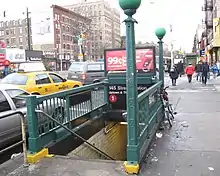
The northbound local track merges with the center track north of the station and the line continues north as two tracks. The switch from the southbound track to the center track is south of the station.[31]
Just south of the station lies the underground 137th Street Yard, which is visible from passing trains. The track layout allows northbound trains to bypass this station by switching to the center express track in the 137th Street Yard.[31]
Exits
Both platforms have same-level fare control containing a bank of turnstiles, token booth, and staircases to the street. The northbound platform has two staircases (one to each eastern corner of Broadway and 145th Street) and the southbound platform has a single staircase to the northwestern corner. There are no crossovers or crossunders to allow transfers between directions.[33]
References
- "Our Subway Open: 150,000 Try It; Mayor McClellan Runs the First Official Train". The New York Times. October 28, 1904. p. 1. ISSN 0362-4331. Retrieved April 21, 2020.
- "Station Developers' Information". Metropolitan Transportation Authority. Retrieved June 13, 2017.
- "Facts and Figures: Annual Subway Ridership 2014–2019". Metropolitan Transportation Authority. 2020. Retrieved May 26, 2020.
- Walker, James Blaine (1918). Fifty Years of Rapid Transit — 1864 to 1917. New York, N.Y.: Law Printing. Retrieved November 6, 2016.
- "Interborough Rapid Transit System, Underground Interior" (PDF). New York City Landmarks Preservation Commission. October 23, 1979. Retrieved 2019-11-19.
- Report of the Board of Rapid Transit Railroad Commissioners for the City of New York For The Year Ending December 31, 1904 Accompanied By Reports of the Chief Engineer and of the Auditor. Board of Rapid Transit Railroad Commissioners. 1905. pp. 229–236.
- Report of the Board of Rapid Transit Railroad Commissioners For And In The City of New York Up to December 31, 1901. Board of Rapid Transit Railroad Commissioners. 1902.
- Report of the Public Service Commission For The First District of the State of New York For The Year Ending December 31, 1909. Albany: Public Service Commission. 1910.
- "New York City's Subway Turns 100" (PDF). The Bulletin. Electric Railroaders' Association. 47 (10). October 2004. Archived from the original (PDF) on April 3, 2018. Retrieved April 2, 2018.
- Report of the Public Service Commission For The First District of the State of New York For The Year Ending December 31, 1909. Albany: Public Service Commission. 1910.
- Report of the Public Service Commission For The First District of the State of New York For The Year Ending December 31, 1909. Albany: Public Service Commission. 1910.
- "Our First Subway Completed At Last — Opening of the Van Cortlandt Extension Finishes System Begun in 1900 — The Job Cost $60,000,000 — A Twenty-Mile Ride from Brooklyn to 242d Street for a Nickel Is Possible Now". The New York Times. August 2, 1908. p. 10. Retrieved November 6, 2016.
- "Our First Subway Completed At Last — Opening of the Van Cortlandt Extension Finishes System Begun in 1900 — The Job Cost $60,000,000 — A Twenty-Mile Ride from Brooklyn to 242d Street for a Nickel Is Possible Now". The New York Times. August 2, 1908. p. 10. Retrieved November 6, 2016.
- Brooklyn Daily Eagle Almanac. Brooklyn Daily Eagle. 1916. p. 119.
- "Open New Subway Lines to Traffic; Called a Triumph" (PDF). The New York Times. August 2, 1918. p. 1. ISSN 0362-4331. Retrieved October 4, 2011.
- Hood, Clifton (1978). "The Impact of the IRT in New York City" (PDF). Historic American Engineering Record. pp. 146–207 (PDF pp. 147–208). Retrieved December 20, 2020.
 This article incorporates text from this source, which is in the public domain.
This article incorporates text from this source, which is in the public domain. - Report of the Public Service Commission for the First District of the State of New York For The Year Ending December 31, 1910. Public Service Commission. 1911.
- "Ten-car Trains in Subway to-day; New Service Begins on Lenox Av. Line and Will Be Extended to Broadway To-morrow". The New York Times. January 23, 1911. ISSN 0362-4331. Retrieved April 5, 2018.
- Report for the three and one-half years ending June 30, 1949. New York City Board of Transportation. 1949. hdl:2027/mdp.39015023094926.
- "More Long Platforms – Five Subway Stations on IRT to Accommodate 10-Car Trains" (PDF). The New York Times. July 10, 1948. p. 8. ISSN 0362-4331. Retrieved March 27, 2016.
- Brown, Nicole (May 17, 2019). "How did the MTA subway lines get their letter or number? NYCurious". amNewYork. Retrieved January 27, 2021.
- Friedlander, Alex; Lonto, Arthur; Raudenbush, Henry (April 1960). "A Summary of Services on the IRT Division, NYCTA" (PDF). New York Division Bulletin. Electric Railroaders' Association. 3 (1): 2.
- "Wagner Praises Modernized IRT — Mayor and Transit Authority Are Hailed as West Side Changes Take Effect". The New York Times. February 7, 1959. p. 21. Retrieved November 6, 2016.
- Brozan, Nadine (June 4, 1989). "'Skip-Stop' Subway Plan Annoys No. 1 Riders". The New York Times. ISSN 0362-4331. Retrieved June 15, 2016.
- Moore, Keith (June 10, 1988). "TA's skip-stop plan hit". New York Daily News. Retrieved November 8, 2018.
- "#1 Riders: Your Service is Changing". New York Daily News. August 20, 1989. Retrieved November 8, 2018.
- "Announcing 1 and 9 Skip-Stop Service on the Broadway-Seventh Avenue Line" (PDF). New York City Transit Authority. August 1989. Archived from the original (PDF) on June 26, 2020. Retrieved August 1, 2009.
- Lorch, Donatella (August 22, 1989). "New Service For Subways On West Side". The New York Times. ISSN 0362-4331. Retrieved June 15, 2016.
- Chan, Sewell (January 12, 2005). "MTA Proposes Dropping No. 9 Train". The New York Times. Retrieved April 18, 2010.
- Chan, Sewell (May 25, 2005). "On Its Last Wheels, No. 9 Line Is Vanishing on Signs". The New York Times. ISSN 0362-4331. Retrieved August 29, 2016.
- Dougherty, Peter (2006) [2002]. Tracks of the New York City Subway 2006 (3rd ed.). Dougherty. OCLC 49777633 – via Google Books.
- Framberger, David J. (1978). "Architectural Designs for New York's First Subway" (PDF). Historic American Engineering Record. pp. 1-46 (PDF pp. 367-412). Retrieved December 20, 2020.
 This article incorporates text from this source, which is in the public domain.
This article incorporates text from this source, which is in the public domain. - "MTA Neighborhood Maps: Harlem / Hamilton Heights" (PDF). mta.info. Metropolitan Transportation Authority. 2018. Retrieved October 1, 2018.
External links
| Wikimedia Commons has media related to 145th Street (IRT Broadway – Seventh Avenue Line). |
- nycsubway.org – IRT West Side Line: 145th Street
- Station Reporter – 1 Train
- Forgotten NY – Original 28 – NYC's First 28 Subway Stations
- The Subway Nut – 145th Street Pictures Archived 2018-12-09 at the Wayback Machine
- 145th Street entrance from Google Maps Street View
- Platforms from Google Maps Street View
